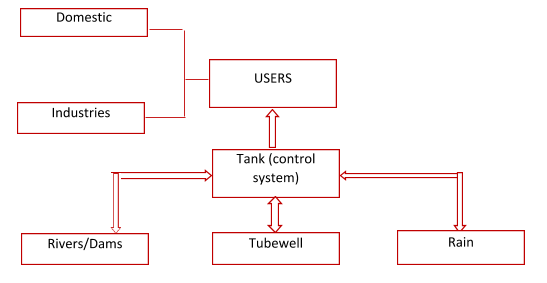
Draw a block diagram of water resources in your village.
Answer
565.2k+ views
Hint: Water is one of the basic physicochemical components of the ecosystem and is a natural resource. It is potentially a useful resource which is used by each and every living organism in different quantities. Different sources of water in the village comes under the block diagram of water resources in the village. The important sources of water are oceans, rivers, streams, groundwater and rainfall.
Complete answer:
Living organisms require water as an important element for their sustain and survival. Water is used for several processes such as household, agricultural needs, industrial purpose as well as for different environmental activities. The two types of water are marine water and freshwater. Marine water found in the oceans and seas have a high salt concentration and is unfit for drinking purposes. The freshwater sources such as ground water or rivers, streams can be utilized for drinking and other purposes.
The water resources of the villages can be described as follows:
The villagers are getting water from lakes, rivers, etc. This is the village's main water resource. Some of the villagers even dug water wells. Water with a hand pump can be obtained. Some of them wash their clothes in river water. There are even villagers bathing in the rivers. Some people even practice rainwater harvesting by storing rainwater on their houses' roofs or terraces.
The block diagram of water resources in the village is shown below:

Additional Information:
Groundwater and surface water are the main sources of drinking water in villages. Moreover, precipitation can be gathered and stored (rain and snow). The original water quality depends on the source. Water from surface (lakes, ponds, streams and rivers) is usually low in quality and requires comprehensive care for around fifty percent of the population. Groundwater is a better-quality source for about fifty percent of the population. However, liquid waste, including leachate from solid waste landfills can also be polluted or by farm runoff or the surface and subsurface disposal are known to contaminate the freshwater sources of water.
Other sources, including spring water and rain water, differ in consistency, but can be produced and handled to ensure that it is safe.
Note: In villages, water can be obtained from different sources such as dams, perennial ponds, rivers, streams, or by digging wells and others. There are a number of ways in which water management in villages can be adopted such as rainwater harvesting and others. However, the water sources are also subjected to different types of pollution and become contaminated leading to release of harmful toxins and algal blooms. This makes the water unfit for consumption or other activities.
Complete answer:
Living organisms require water as an important element for their sustain and survival. Water is used for several processes such as household, agricultural needs, industrial purpose as well as for different environmental activities. The two types of water are marine water and freshwater. Marine water found in the oceans and seas have a high salt concentration and is unfit for drinking purposes. The freshwater sources such as ground water or rivers, streams can be utilized for drinking and other purposes.
The water resources of the villages can be described as follows:
The villagers are getting water from lakes, rivers, etc. This is the village's main water resource. Some of the villagers even dug water wells. Water with a hand pump can be obtained. Some of them wash their clothes in river water. There are even villagers bathing in the rivers. Some people even practice rainwater harvesting by storing rainwater on their houses' roofs or terraces.
The block diagram of water resources in the village is shown below:

Additional Information:
Groundwater and surface water are the main sources of drinking water in villages. Moreover, precipitation can be gathered and stored (rain and snow). The original water quality depends on the source. Water from surface (lakes, ponds, streams and rivers) is usually low in quality and requires comprehensive care for around fifty percent of the population. Groundwater is a better-quality source for about fifty percent of the population. However, liquid waste, including leachate from solid waste landfills can also be polluted or by farm runoff or the surface and subsurface disposal are known to contaminate the freshwater sources of water.
Other sources, including spring water and rain water, differ in consistency, but can be produced and handled to ensure that it is safe.
Note: In villages, water can be obtained from different sources such as dams, perennial ponds, rivers, streams, or by digging wells and others. There are a number of ways in which water management in villages can be adopted such as rainwater harvesting and others. However, the water sources are also subjected to different types of pollution and become contaminated leading to release of harmful toxins and algal blooms. This makes the water unfit for consumption or other activities.
Recently Updated Pages
Master Class 12 Economics: Engaging Questions & Answers for Success

Master Class 12 Maths: Engaging Questions & Answers for Success

Master Class 12 Biology: Engaging Questions & Answers for Success

Master Class 12 Physics: Engaging Questions & Answers for Success

Basicity of sulphurous acid and sulphuric acid are

Master Class 12 Business Studies: Engaging Questions & Answers for Success

Trending doubts
How much time does it take to bleed after eating p class 12 biology CBSE

Explain sex determination in humans with line diag class 12 biology CBSE

Differentiate between homogeneous and heterogeneous class 12 chemistry CBSE

When was the first election held in India a 194748 class 12 sst CBSE

Explain sex determination in humans with the help of class 12 biology CBSE

December 10th of 1948 is an important day in the history class 12 sst CBSE




